
Traditional Games Making a Comeback
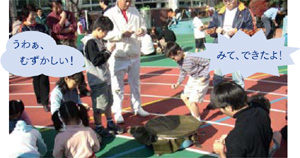 Children’s cries of delight echo through the gymnasium of an
elementary school. During the periods set aside for integrated
study at this school, elderly neighbors are invited to interact with
students through traditional games, such as kendama (cup and
ball), koma (tops), and otedama (beanbag juggling). Many kindergartens
and nursery schools, as well as elementary schools have
recently been holding such activities. Changes that have recently
taken place in children’s environments led to the active integration
of such games in schools.
Children’s cries of delight echo through the gymnasium of an
elementary school. During the periods set aside for integrated
study at this school, elderly neighbors are invited to interact with
students through traditional games, such as kendama (cup and
ball), koma (tops), and otedama (beanbag juggling). Many kindergartens
and nursery schools, as well as elementary schools have
recently been holding such activities. Changes that have recently
taken place in children’s environments led to the active integration
of such games in schools.
“Oh, this is hard!” “Look, I did it!”
© Sato Hiroaki
Children’s Environments
What Japanese children do for fun has changed dramatically in the
past 20 years. When Nintendo first started selling famikon in 1983,
it became an instant hit. Subsequently, portable digital games
have gone on the market one after the other, and by now even
computer and cell phone use has spread among young children.
According to a study conducted by Benesse Educational Research
and Development Center,* elementary school students
play video games after school for an average of one hour. While
over 20 percent of elementary school students play video games
hardly at all, another 20 percent play for two or more hours. If
we were to include other digital games, the figure would be even
higher. Over 60 percent play in their own home or in a friend’s
home. Video and digital games are not the only things that have
influenced the change in where children play, from outdoors to
indoors. The number of places where children can safely play has
decreased, it is said, as a result of urban development and crimes
perpetrated against children. Furthermore, we see a decrease in
cross-generational communication and the undermining of the
local community due to an increase in nuclear families.
There is a heightened sense of crisis concerning children’s
environments. We often hear about the decline in children’s
athletic agility and strength because of little time spent actively
playing outside as well as the deterioration of children’s communication
skills from spending so much time playing alone.
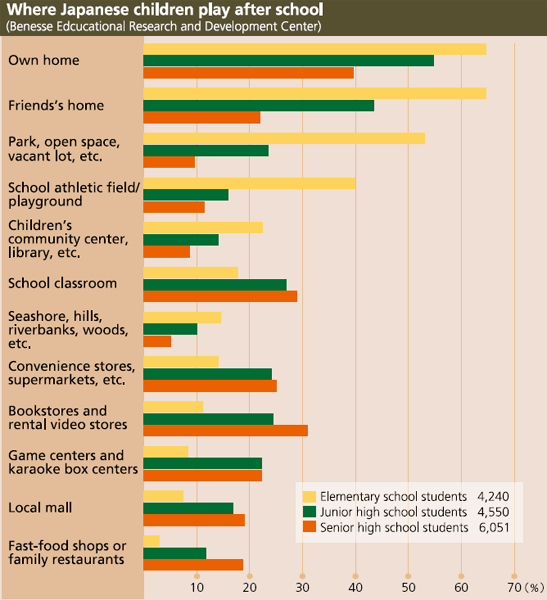
* Dai-ikkai Kodomo seikatsu jittai kihon chosa hokokusho [Report of the 1st Basic Survey on Conditions of Children’s Daily Lives], 2005.
Merits of Traditional Games
Many traditional games require physical activity. These games help develop
children’s physical agility and strength, foster perseverance and concentration,
and develop balance without them even knowing it. For example, kendama appears
to require the use of just the fingertips, but in fact, one must bend and stretch
the knees, and maintain balance using the entire body. Learning to wrap the throwing
cord around a koma top and tossing it correctly, or getting a small top to spin
on the palm of your hand demands hours of practice.
In addition, traditional
games can be enjoyed across generations, allowing people of different ages to
interact. Elderly neighbors can be invited to join in, thereby fostering a sense
of local community. One of the main aims in adopting traditional games in the
schools is to create opportunities for children to interact with different kinds
of people.
Many local governments run programs to provide children with safe
places to play, and traditional games often make an appearance in these programs.
Local communities also hold traditional game events. However, this means that
traditional games are no longer played on a daily basis. They were originally
passed down from parents to children and grandchildren, but today, with growing
numbers of nuclear families and society overflowing with toys, traditional games
are not easy to pass down. Nevertheless, more than a few children have become fascinated
by the special appeal of traditional games, which offer
pleasures digital games lack.
Traditional Games Common Around the World
Since kendama, koma, otedama, takeuma (stilts), tako-age (kiteflying), ayatori (cat’s cradle) are often introduced as traditional Japanese games, many children think that they are unique to Japan. However, similar toys and games can be found all around the world. Some may have been invented in one place and spread to other areas, while others may have coincidentally been invented in different places. It is no surprise that similar children’s toys made from readily available materials are seen around the world, though the materials may differ from place to place. Traditional toys that are almost the same, but are somehow different: it can be interesting to compare the various toys of the world. Here we introduce traditional toys that are widely popular in Japan.
Kendama
Cup and Ball
けんだま
Playing with kendama (lit., “sword and ball”) begins by swinging
the ball onto the small, medium, or large “plate (cup),” or
making the ball, where it has a hole on one side, fall on the tip
of a shaft at one end, called the “sword” (ken). The first challenge
is to get the ball to land on the large plate, then on the
medium and small plates. The next trick is to make the ball fall
on the shaft. This covers the basic moves of the game. After
that, everything involves combining the different moves. Many
people create original moves, and there are said to be over
1,000 tricks in all.
The roots of kendama are said to be found
in the French bilboquet (see right side in left box below), a game played in
Europe during the nineteenth century. In France, it was played
by aristocrats, while in England, it was a game for girls.
Kendama is said to have reached Japan from China via
Nagasaki during the Edo period (1603-1867). At the time, it
was comprised of a straight stick and a ball. Kendama as we
know it today, with three plates and a sword tip, was invented
in Hiroshima during the Taisho period (1912-1926). It was an
instant hit among children, and was commonly played until
the early Showa period (1926-1989).
To promote the spread of kendama as a sport, the NPO
Japan Kendama Association founded in 1975 created a standard
kendama for competition (kendama with approval stickers
are used at competitions), and a rulebook. Today, competitions
and grade (kyu, dan) certification meets take place around the country. Skill
is ranked in ten kyu (rising from 10 to 1) and six dan (rising from 1 to 6).
The Ministry of Education, Culture, Sports, Science and
Technology is also focusing on games as a way to improve
children’s physical strength. Since kendama is recognized as a
game that requires balance and helps exercise the entire body,
including the back and knees, “caravans” comprised of people
well-versed in kendama are set to tour elementary schools
starting in the 2007 school year.
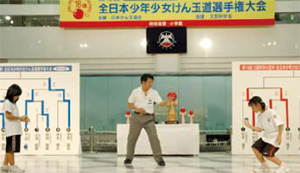 <- The All-Japan Young People’s Kendama Championship
Tournament takes place every summer. An elementary school boy and girl who advance
through a regional block play in the tournament with their counterparts from
other regions. There are ten regional blocks in the country.
<- The All-Japan Young People’s Kendama Championship
Tournament takes place every summer. An elementary school boy and girl who advance
through a regional block play in the tournament with their counterparts from
other regions. There are ten regional blocks in the country.
Kendama Around the World
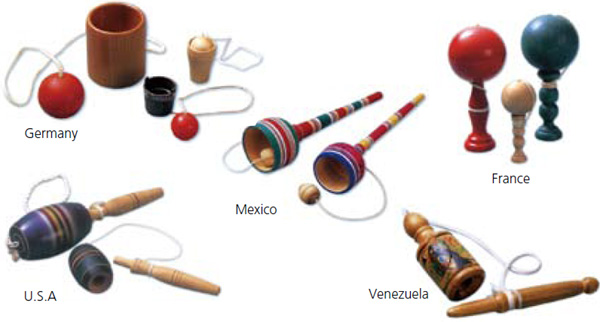 Photos from Kendama, 2003 Published by BUNKEIDO Co., Ltd.
Photos from Kendama, 2003 Published by BUNKEIDO Co., Ltd.© NPO Japan Kendama Association, Teruki MARUISHI, Ichiro SUZUKI & Yuji CHIBA
Japanese Kendama
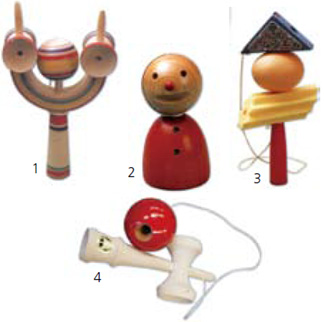 <-© NPO Japan Kendama Association,
Teruki MARUISHI, Ichiro SUZUKI & Yuji CHIBA
<-© NPO Japan Kendama Association,
Teruki MARUISHI, Ichiro SUZUKI & Yuji CHIBA
Koma/Beigoma
こま/ベイゴマ
There are many types of koma—those spun with the fingers
(hinerigoma), with the palms of the hands (temomigoma), by
pulling a cord (itohikigoma), by throwing the top using a cord
wrapped around it (nagegoma), and others. The kind often introduced
as a traditional toy is the “throw top” (nagegoma).
Some are made of wood, and some of cast metal (beigoma).
Beigoma are steel tops that have no stem. They are spun
by throwing with a string about sixty centimeters long wound
around the base. One game is played by spreading a sheet over
the bottom of a barrel and pressing it down in the middle to
create a playing surface, on which two players spin their respective
tops until one flicks the other off the surface. It is difficult
to wind the string tightly since the top has no stem, and
spinning the beigoma requires considerable skill.
It is said that koma came to Japan from China, but the details
are unknown. Koma were already popular among the common
people in the Kamakura period (1192-1333), but it was during
the Edo period that they flourished. The best known were
the beigoma made by filling whelk shells with sand or lead and
then sealed with wax. This was the beginning of the beigoma.
The production of beigoma we now know, made by pouring
steel into moulds, started in the late Meiji to mid-Taisho periods.
Beigoma etched with the names of professional baseball
players and sumo wrestlers were very popular among children
in the shitamachi (“low city”) area of Tokyo from the 1920s to
the early 1930s. Since steel was collected during World War II
for the war effort, beigoma during that time were made of china
or glass instead.
After World War II, from 1945 to the early 1960s, beigoma
was the most common game among children. There were
many factories manufacturing beigoma, but today, there is
only one left in Kawaguchi, Saitama prefecture. Still, there are
many beigoma fans, and every week, competitions, both large
and small, take place in parks and various other locations.
- Japan Spin a Top Association
- Japan Spinning Top Musuem
- Nihon Komamawashi Fukyu Kyokai (Japan Spinning Top Promotion Association)
- Nihon Beigoma Kyokai (Japan Beigoma Association)
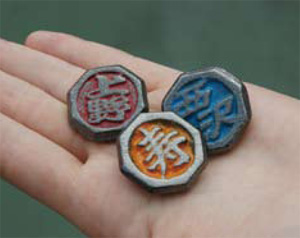
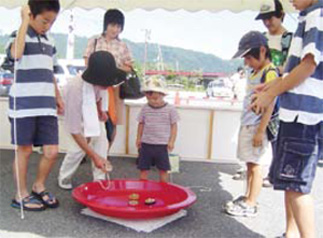
(left) Beigoma imprinted with names of people or places. © TJF
(right) In 2006 the 7th All-Japan Top-spinning Contest was sponsored by the Japan Spin a Top Association.
© Koma no Sato
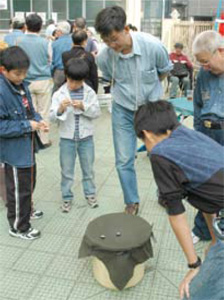 <- Children and adults of all ages enjoyed beigoma
in a festival in the old shitamachi area of Tokyo.
<- Children and adults of all ages enjoyed beigoma
in a festival in the old shitamachi area of Tokyo.
© TJF
Acrobatic Tops
Kyokugoma きょくごま
In addition to children’s toy tops, there are beautifully shaped and colored tops used for acrobatic displays. Performers delight audiences with various tricks, such as making a spinning top slide along the blade of a sword or move along a slender cord, and balancing a spinning top on the edge of an open fan (see photo below; Mimasu Monya’s performance). These feats, which require years to master, are often performed at celebratory occasions such as New Year’s.
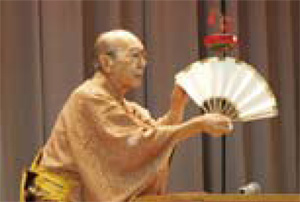
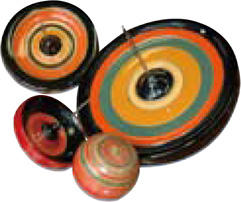 © TJF
© TJF
Japanese Tops
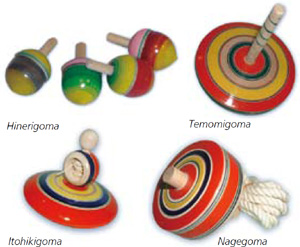
<- © Koma no Sato
Otedama
Beanbags
おてだま
Otedama are fabric bags filled with red azuki beans, kernels of rice, or plastic
pellet which one plays with juggling, throwing and catching several simultaneously
while singing a traditional ditty. The names of the game, pellets used to fill
the bags, shape of the bags, and the ways they are played with vary from region
to region.
The origins of otedama are said to go back to a game played by nomads
living near the Black Sea around 1200 B.C. which spread all over the world via
the Silk Road. In Japan, it has been passed down from mothers to their daughters
from about 1,200 years ago, but since around 1970, it has not been so commonly
played. Nowadays, otedama are still sold, but they seem to be more for decoration
than for play.
Juggling Toys from Around the World
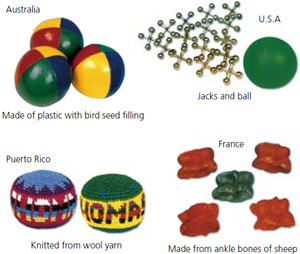 <- Photos and captions from Otedama, 1997 Published by BUNKEIDO Co.,Ltd. © NIHON-NO-OTEDAMA-NO-KAI & Denichirou OHNISHI
<- Photos and captions from Otedama, 1997 Published by BUNKEIDO Co.,Ltd. © NIHON-NO-OTEDAMA-NO-KAI & Denichirou OHNISHI
Takeuma
Stilts
たけうま
Takeuma are stilts made by fixing crosspieces near the bottom of bamboo poles
one to two meters long. One stands on the crosspieces and walks while holding
onto the poles at the top. The origin of the word takeuma (lit., “bamboo horse”)
comes from an ancient Chinese game in which people rode bamboo contrivances made
to use like horses. It is said that takeuma as we know them today became widespread
from the Edo period onwards.
Today, takeuma made from plastic are the norm. Playing
with takeuma is said to be useful in fostering balance, and it is a common fixture
of play equipment, along with unicycles, at elementary schools and children’s
recreation centers. There are some elementary schools that invite grandparents,
parents, and children to make their own takeuma; students help one another in
making their stilts in class, and hold competitions in which footraces and relay
races are all done on stilts.
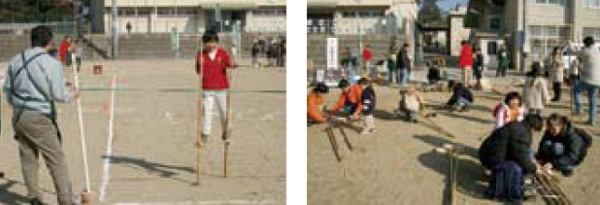
5th National Takeuma Contest sponsored by the Chamber of Commerce of the city of Muko, Kyoto prefecture, in January 2007. A takeuma workshop for parents with their children was also held.
© Muko City Society of Commerce and Industry
Japanese Otedama
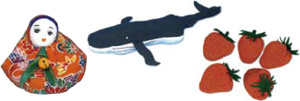 Photos and captions from Otedama, 1997 Published by BUNKEIDO Co.,Ltd. © NIHON-NO-OTEDAMA-NO-KAI & Denichirou OHNISHI ->
Photos and captions from Otedama, 1997 Published by BUNKEIDO Co.,Ltd. © NIHON-NO-OTEDAMA-NO-KAI & Denichirou OHNISHI ->
Modern Versions of Traditional Toys
Some traditional toys have been revamped by toy manufacturers to appeal to
children of today. For example, there is Beyblade, which is a spinning top modeled
on the beigoma, as well as DIGI-KEN (dejiken), a digitalized version of kendama,
with flashing lights and sounds.
What they all have in common is the ease with
which one is able to acquire the skills to enjoy them, compared to traditional
toys. With Beyblade, one attaches the top to a special device that anyone can
spin. Another characteristic is that many of these games are tie-ins with manga,
video games, and anime. Beyblade, which went on the market in 1999, became popular
after characters in manga played with it and its anime version was aired on television.
Its popularity rose to the extent that national competitions were held, and in
the first half of the fiscal year 2001, over 15 million were sold.
The popularity
of such modern versions of traditional toys is fleeting, and both Beyblade and
DIGI-KEN are no longer on the market. However, the popularity of Beyblade led
to renewed interest in beigoma, and an increase in beigoma playing population.
These modern versions of traditional toys, which provided people a shortcut to
enjoyment, in fact led to a renewed interest in traditional toys that offer the
pleasure to be gained when you take time to polish your skill.
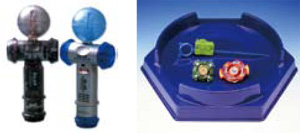 (left) DIGI-KEN
(left) DIGI-KEN
This photo is from Kendama, 2003 Published by BUNKEIDO Co., Ltd.
© NPO Japan Kendama Association, Teruki MARUISHI,
Ichiro SUZUKI & Yuji CHIBA,
© 1998 TOMY
(right) Beyblade
© HUDSON SOFT/ TAKARA, Beyblade Project, TV Tokyo
Original text : Takarabako No.11 “Japanese
Culture Now” March 2007.
Copyright(C)1997-2008 The Japan Forum. All rights reserved.
Send feedback to forum@tjf.or.jp